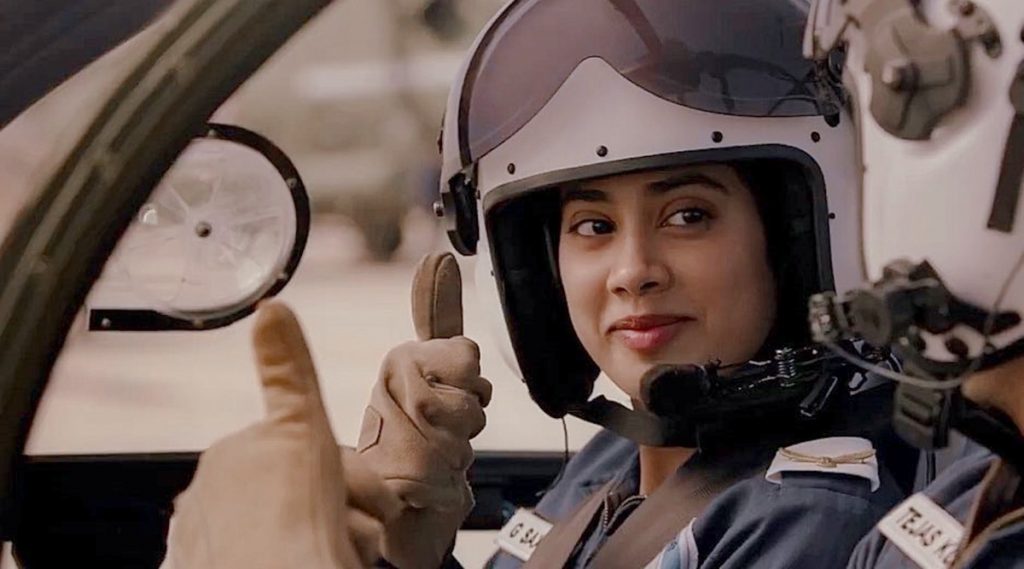The best part of Gunjan Saxena: The Kargil Girl lies in its dynamism, its action, its rapid change of scene and its positioning of the main characters including the subtle changes in their interaction. There is not a boring minute for the audience and the director, Sharan Sharma, guarantees that they will stay hooked to their computer or television screens. This is a major achievement given that it is a direct-to-OTT release; one that throws up enough distractions for the viewers. The film, as is well-known by now, is based on the true story of Gunjan Saxena who retired as Squadron Leader with the Indian Air Force (IAF) and who was a former helicopter pilot. She joined the IAF in 1994 and is now a 1999 Kargil war veteran besides being the first woman in the IAF to be decorated with the Shaurya Chakra. She is also the first woman IAF Officer to go to war. One of her main roles during the Kargil War was to evacuate the wounded from Kargil, transport supplies and assist in surveillance.
Gunjan Saxena: The Kargil Girl, thankfully, without trying to romanticize her story or making a jingoistic war film, focusses mainly on Gunjan’s own battles – on the outside and within – and on the father-daughter relationship in the first half which is brought out with some power and a strong emotional resonance. The credit for this goes mainly to the wonderful Pankaj Tripathi, who continues to surprise us with every single performance of his. When a disillusioned and humiliated Gunjan announces that she wants to quit the IAF and to ‘settle down’, he takes her to the kitchen to show her how to make aloo parathas and she is totally confused because she knows nothing of cooking. He then explains that if she were to quit now, it would be his loss too because he had not just dreamt for her but also along with her. This is, undoubtedly, one of the best moments in the film. Well iptv providers can provide you many best films and show under one platform.
The entire film is an intense study of the gender bias every woman wanting to break male barriers must not only confront but also cross, at the risk of falling by the wayside at any given point without reaching her destination. Once Gunjan steps into the IAF, there is only one superior who gives her a fair chance in flying sorties or commanding a sortie. But the same person, does not supervise whether his orders are obeyed or not. He understands the tremendous patriarchal dictates Gunjan is being subject to but he does not do much about it except giving her the chance to improve her flight grades under his direct supervision.
The humiliation, the overt and covert insults Gunjan has to face every single day push her to the brink. Junior cadets turn around so that they do not have to salute a woman officer. The men in the bar within the army mess leave her alone when she steps in at the end of the day’s hard work while the men are enjoying their drinks and their music so she stops going there. The one message that comes out loud and clear is this – gender bias and harassment at the workplace can happen without any man ever touching a woman, or making dirty remarks at her, or trying to take physical advantage of her position. It can be silent but equally threatening for any woman.
Barring her father, Gunjan faces stern opposition from family members too. Her brother, also in the Defence Forces, keeps on discouraging her with the same sexist remarks her male colleagues silently use against her. When he tells her that the society thinks differently about women fighter pilots, she asks him, “Why don’t you make a beginning by changing your stance?” He has no answer to this. Angad Bedi, as the brother, does well in a brief cameo while Vineet Kumar Singh is excellent as her stern superior officer who is convinced that a woman just cannot be a flight commander in the IAF. Finally, when the Kargil war breaks out, she sets out to prove to herself and to the IAF that she belongs to what she is really capable of. And prove herself she does even causing her very doubtful mother to change her rigid stance towards her in the end.
While much works in the film, Janhvi Kapoor is too raw yet to pull off a challenging, nuanced character like Gunjan Saxena on celluloid. Even so, she has tried to give her best and it helps that the director manages to successfully blends the young actress’ off-and-on hesitancy and sometimes lack of confidence (as a relatively new actress) with the uncertainties of the character she is playing on screen. This was a clever decision and aids the film (and the character) greatly in spite of Janhvi’s inconsistent act.
The editing with its constantly shifting focus from Lucknow to Udhampur and other places, apart from the war scenes and the sorties, has been done exceptionally well and is seamless. Nitin Baid sustains his standards of wonderful and versatile editing ever since he broke through with Masaan in 2015 and followed it up with some fine work in films like Trapped (2016), Raazi (2018) and Gully Boy (2019). Manush Nandan’s camera is also suitably impressive while Amit Trivedi’s music and Kausar Munir’s lyrics fit neatly into the changing moods of the script but the film could very well have done without any songs whatsoever.
The film, having enough going for it, may have perhaps been a better bet both commercially and critically had it been released in theatres. But even on an OTT platform, it keeps one engaged even as it makes a pertinent point or two. And that is its biggest strength.
Hindi, Drama, Biopic, Color


